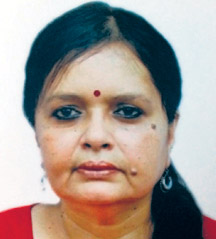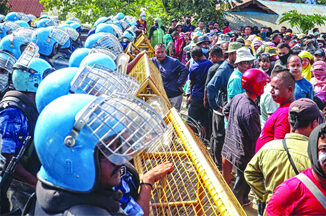

“The BJP has travelled a long way from the early 2000s, when Vajpayee had to be mindful of his allies’ seeming distaste for communal politics. The Maharashtra and Delhi civic polls will test the BJP’s reinvigorated Hindutva programme. In Maharashtra, it has tied up with Raj Thackeray’s Maharashtra Navnirman Sena and backed its call to remove loudspeakers from mosques. In Delhi, the Hindu-Muslim fault lines evident after the Jahangirpuri violence might resonate across the city.”
It is incomprehensible what program of action the Rashtriya Swayamsevak Sangh (RSS) and its cohorts will spring upon the country each day. For decades, the BJP grappled with the dilemma of whether a linear progression of Hindutva best suited its politics, although the paterfamilias, residing at Nagpur, was clear that the doctrine of Hindu supremacy should be at the heart of the agenda it laid out for its political progeny. The BJP cut the first turf every now and then, but only just because it never lost sight of the fact that as it grew through childhood and adolescence, it relied on the parent for mid-course correction.
When Atal Bihari Vajpayee advocated Gandhian socialism and JP’s legacy after the BJP lost elections serially, his theories were rebuffed once the party was routed in the 1984-85 elections. Vajpayee was critiqued for missing the mark. Sikh militancy had overrun north India and the Congress played to Hindu angst and anger. LK Advani stepped in to lead the Rath Yatra across the country and create a narrative against Islamic rule, symbolized by the ‘destruction’ of hallowed places, notably the birthplace of Lord Ram in Ayodhya. Of course, he was fortunate in that the RSS and the Vishwa Hindu Parishad (VHP) had done the spadework before his chariot rolled. Advani put his finger on the pulse and handed out the BJP’s initial victories, enabling it to reach that critical mass which made it a contender to lead an anti-Congress Opposition. However, when it came to heading a coalition government, Vajpayee was chosen as the BJP/NDA’s PM candidate because his ‘moderate’ visage, in contrast to Advani’s militant Hindu image, appealed to allies who had to rationalize their decision to go with the BJP before their ‘secular’ constituents. Everything has changed unrecognizably now. Like Vajpayee’s socialism of 1985, Advani’s project to refurbish perceptions about himself by endorsing Muhammad Ali Jinnah publicly in Karachi almost broke the BJP’s back. The BJP’s architect had to go.
Narendra Modi, Advani’s successor, resolved every dilemma confronting the BJP and the Parivar seamlessly to take the party to heights the RSS never imagined. He was so powerful as the Gujarat chief minister — a position he consolidated by pursuing and embracing a radicalized stream of Hindutva without qualms, unlike Advani — that he could put down the occasional transgressions by the VHP or another Parivar member with ease. Modi successfully persuaded voters in northern and western India to give the Gujarat admixture of radical Hinduism — underpinned with deep-rooted antagonism towards the minorities — and ‘development’ fashioned after his notions of capitalism (welfare and populism were remarkably absent from the model because he often said he subscribed to people’s empowerment and not their entitlement) a chance to ‘prove’ itself at the Centre.
Modi’s 2014 campaign astutely centered ‘development’ (signified by the promise of investments and infrastructure) over Hindutva but he allowed the others in the BJP to talk up his credentials as the ‘Hindu hriday samrat’ (monarch of the Hindu heart) so that voters were convinced that they were in for a double bonanza: economic prosperity and Hindu asmita (identity) which ‘vanished’ during colonial rule. The formula worked quite successfully, although its limitations were exposed in the eastern and southern regions where the BJP still struggles to break through. The BJP might not have won every state election but once victory came its way, it fought hard to retain it in a successive election. However, the BJP’s recent second-time triumphs were determined by using Hindutva laced with populist welfare.
Assam and Uttar Pradesh are examples of the BJP’s determination to hold on to states wrested the hard way. The outcomes in both cases are similar. Assam is characterized by multiple ethnic, religious and linguistic identities. Even a party in pole position such as the Congress earlier and now the BJP had perforce to weave a coalition by making common cause with smaller entities with a niche following. The BJP’s use of Hindutva did not prevent the latest incarnation to emerge from the Adivasi-dominated Bodo region from joining hands and trumping its adversaries. Likewise, in UP, the leadership by an individual in saffron robes, who unabashedly swore by and deployed Hindutva to fulfil his agenda, never deterred identity-based outfits from taking shelter under the BJP umbrella and looking the other way when minorities were hunted down and victimized. Obviously, the party has travelled a long way from the 1990s and early 2000s, when Vajpayee had to be mindful of his allies’ seeming distaste for communal politics.
Modi’s victories in Gujarat were the tipping point of the BJP’s ascendancy. The social sanction for the 2002 violence spurred an active debate on the secular-communal issue and tilted the ideological balance in the latter’s favor. Therefore, it is highly improbable that the BJP will go back on the path it walked since 2019. In his first tenure, Modi mixed ‘governance’ and Hindutva almost in equal measure and was a tad defensive when the Parivar’s cattle vigilantes and ‘reconversion’ (shuddhikaran) crusaders showed their intent through lynching and coerced conversion. Post 2019, the Hindutva zealots felt so empowered that when the police tried to crack down on the VHP after the recent Jahangirpuri occurrences in Delhi, the VHP protested, and the cops promptly pulled back. Contrast the VHP’s withdrawal with Modi’s clampdown on Parivar constituents, notably the VHP, in Gujarat whenever they disagreed and protested government policies.
The Maharashtra and Delhi civic polls scheduled to be held this year will test the BJP’s reinvigorated Hindutva programme. In Maharashtra, it has tied up with Raj Thackeray’s Maharashtra Navnirman Sena and backed its call to remove loudspeakers from mosques. In Delhi, the Hindu-Muslim fault lines evident after the Jahangirpuri violence might resonate across the city.
(The author is a senior journalist)





Be the first to comment